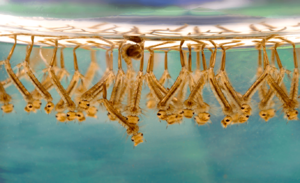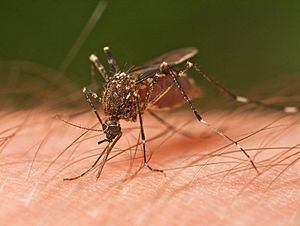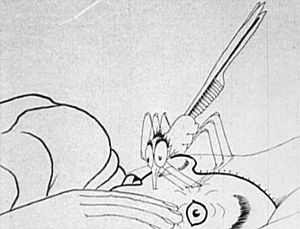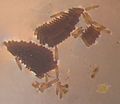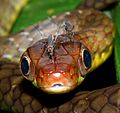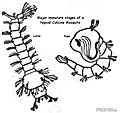Mosquito facts for kids
Quick facts for kids Mosquito |
|
|---|---|
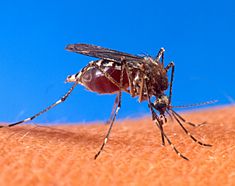 |
|
| Aedes aegypti: the vector of dengue fever and yellow fever |
|
| Scientific classification | |
| Kingdom: | |
| Phylum: | |
| Class: | |
| Order: | |
| Suborder: | |
| Family: |
Culicidae
|
| Subfamilies | |
|
Anophelinae |
|
| Diversity | |
| 43 genera | |
A mosquito is a small type of fly. It belongs to a family of flies called Culicidae. The word "mosquito" comes from Spanish and means "little fly".
Female mosquitoes are like tiny vampires! They land on warm-blooded animals, like humans, and use their special mouthparts to pierce the skin. They inject saliva to stop the blood from getting thick, then they suck up the blood. Sometimes, tiny, harmful parasites live in their saliva.
Male mosquitoes and even female mosquitoes usually drink nectar from flowers. But when a female mosquito needs to lay her eggs, she needs protein. That's why she looks for a blood meal!
Contents
How Mosquitoes Evolved
The oldest mosquito that looks a lot like modern ones was found in 79-million-year-old Canadian amber. Amber is like fossilized tree sap. This mosquito lived during the Upper Cretaceous period. Scientists also found an even older mosquito, about 90 to 100 million years old, which had more basic features.
Scientists have studied mosquito genes. They think that the two main groups of mosquitoes, Culicinae and Anophelinae, might have split apart about 150 million years ago. The Anopheles species from the Old World (like Europe and Asia) and the New World (like the Americas) likely separated about 95 million years ago.
Mosquito Life Cycle and Reproduction
Both male and female mosquitoes usually drink nectar and plant juices. But for many species, the female needs to drink blood before she can make her eggs. The blood gives her the protein she needs. Some species can lay a few eggs without blood, but they can lay many more after a blood meal.
Mosquitoes lay their eggs in still water, like ponds or puddles. The tiny mosquito larvae hatch from the eggs. They swim near the water's surface, breathing through tubes that stick out of the water. They eat algae and other tiny things in the water. People sometimes call them wigglers because of how they move! After a few days or weeks, depending on the water temperature and the type of mosquito, the larvae turn into pupae.
The pupae are called tumblers because they tumble around if the water is disturbed. Tumblers don't eat, but they still breathe through tubes at the surface. This stage is short, only a few days. Then, the adult mosquito comes out of the pupa.
There are over 3,500 different kinds of mosquitoes! Each kind is often suited to feed on a specific animal or group of animals.
Mosquitoes and Diseases
Mosquitoes are known as "vectors" because they can carry viruses and parasites that cause diseases. They pass these germs from one person to another.
Some of the most serious diseases spread by mosquitoes are yellow fever, dengue fever, and malaria. These are carried by different types of mosquitoes, like Anopheles and Culex. Mosquitoes spread diseases to more than 700 million people every year in places like Africa, South America, Central America, Mexico, and much of Asia. Sadly, millions of people die from these diseases each year.
How to Control Mosquitoes
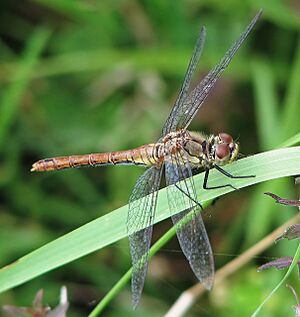
There are ways to stop mosquitoes from spreading diseases and to protect yourself:
- Controlling Mosquitoes: This means trying to get rid of mosquitoes.
**Habitat Change: Remove standing water where mosquitoes lay eggs, like in old tires or buckets. **Pesticides: Sometimes special chemicals are used to kill mosquitoes. **Natural Predators: Encourage animals that eat mosquitoes. **Trapping: Use traps to catch mosquitoes.
- Preventing Bites: This means stopping mosquitoes from biting you.
**Medicines and Vaccines: For some diseases, there are medicines you can take or vaccines you can get. **Repellents: Use bug spray on your skin. **Nets: Sleep under mosquito nets, especially in areas where diseases are common.
Water and Mosquitoes
Still water, like in a pond or even a bird bath, is where mosquitoes love to lay their eggs. It's easy to change the water in a bird bath once a week. But for bigger places, it's harder to get rid of the water. In the past, people sprayed water with a chemical called DDT, but that caused a lot of harm. Also, mosquitoes have become very resistant to it.
Natural Bug Repellents
Some people worry about the chemicals in bug sprays like DEET. So, there's a growing interest in natural repellents. These often come from plants and have been used for other purposes before being used to keep mosquitoes away.
Animals That Eat Mosquitoes
Dragonflies are great at controlling mosquitoes! Their young, called nymphs, eat mosquitoes at all stages of their life. Some tiny creatures called copepods also eat mosquito larvae. Many fish, like goldfish, catfish, and minnows, also eat mosquito larvae.
Mosquito Bites
Why Bites Itch
When a mosquito bites you, it injects some of its saliva. Your body's immune system reacts to this saliva. This reaction causes the itching, redness, and swelling you see. Some people react right away, within minutes, and the itch lasts a few hours. Others have a delayed reaction that shows up a day later and can last for up to a week.
Treating Bites
There are many creams and medicines you can use to stop the itching from mosquito bites. Some you can take by mouth, and others you put directly on your skin. For very bad bites, doctors might suggest stronger creams. Some people find that putting something warm or cool on the bite can help.
Mosquitoes in Human Culture
Old Stories
Ancient Greek stories, like "The Elephant and the Mosquito," often showed how a big animal might not even notice a tiny one. These stories came from even older tales in Mesopotamia.
People in Siberia have myths about how mosquitoes came to be. One story tells of a giant who ate people. A hero killed the giant, but the giant wouldn't stay dead. The hero burned the giant, and the ashes turned into mosquitoes that still bother people today! Other myths from different groups of people also say mosquitoes came from the ashes or pieces of a giant creature or demon.
Modern Times
In 1912, Winsor McCay made an early animated film called How a Mosquito Operates. It was very advanced for its time and showed a huge mosquito bothering a sleeping man.
There was even a famous high-speed airplane made between 1940 and 1950 called the de Havilland Mosquito. It was used for many different jobs.
Interesting Facts About Mosquitoes
- Scientists have found and described over 3,500 different kinds of mosquitoes.
- Mosquitoes cause more deaths than any other animal, by spreading diseases. They cause over 700,000 deaths each year.
- You can find mosquitoes almost everywhere in the world! The only places they don't live are Antarctica and a few very cold islands, like Iceland.
- Some flowers, including certain types of daisies, roses, and orchids, are pollinated by mosquitoes.
- In warm, wet places, some mosquitoes are active all year. But in colder areas, they go into a deep sleep (hibernate) during winter.
- Mosquitoes have spread all over the world with the help of humans. They can hitch rides on cars, trucks, trains, ships, and even airplanes!
- No scientific study has shown that electronic devices that make ultrasounds can stop mosquitoes from biting humans.
Images for kids
-
Aedes aegypti, a common mosquito that spreads dengue fever and yellow fever.
-
Anopheles albimanus mosquito feeding on a human arm. This mosquito spreads malaria.
-
An Anopheles larva from southern Germany.
See also
 In Spanish: Culicidae para niños
In Spanish: Culicidae para niños


